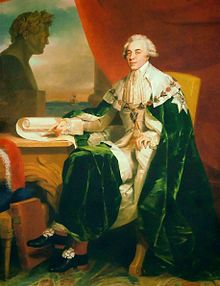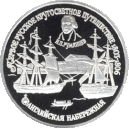Nikolay Rumyantsev
Russian diplomat, minister, chancellor (1809-1826) From Wikipedia, the free encyclopedia
Russian diplomat, minister, chancellor (1809-1826) From Wikipedia, the free encyclopedia
Count Nikolai Petrovich Rumyantsev (Russian: Никола́й Петро́вич Румя́нцев; 3 April 1754 – 3 January 1826), born in Saint Petersburg, was Russia's Foreign Minister and Chancellor of the Russian Empire in the run-up to Napoleon's invasion of Russia (1808–12). He was the son of Field Marshal Pyotr Rumyantsev-Zadunaisky from the Rumyantsev comital family.
Nikolay Rumyantsev | |
|---|---|
 A portrait by George Dawe | |
| Ministers of Foreign Affairs of the Russian Empire | |
| In office 1808–1814 | |
| Chancellor of the Russian Empire | |
| In office 1809–1826 | |
| Personal details | |
| Born | 1754 |
| Died | 1826 |
| Parent(s) | Pyotr Rumyantsev, Yekaterina Rumyantseva |
| Education | Leiden University |
| Signature | |
Rumyantsev and his brother were provided with basic education at home. Their mentor was Friedrich Melchior, Baron von Grimm. In 1774 they went to Leiden University where they studied history, law and language.[1]
Rumyantsev was the first envoy of Russia to the Holy Roman Empire after Russia became a guarantor of the imperial constitution through the Treaty of Teschen (1779). He arrived in 1782 accredited as ambassador to the Electoral Rhenish Circle, Upper Rhenish Circle, Swabian Circle, Franconian Circle, Electorate of Mainz, Electorate of Cologne, Palatine Zweibrücken, Duchy of Württemberg, Margraviate of Baden and Landgraviate of Hesse-Kassel. Although he acted as the representative of Russia as guarantor of the peace, he was considered by Germans to be a partisan of Austria.[2]
During the first years of the 19th century, Rumyantsev was very influential with Alexander I and his mother Maria Fyodorovna, serving as Minister of Commerce (1802–1811) and President of the State Council (1810–1812).
As Foreign Minister (appointed 1808), he advocated a closer alliance with France. Represented Russia at the Treaty of Fredrikshamn. On receiving the news of Napoleon's invasion of Russia (1812), he suffered a stroke and lost his hearing. When Napoleon entered Moscow, he advised the Emperor to dismiss Kutuzov and to seek peace at any cost. Eventually Alexander lost all confidence in Nikolay Petrovich, who retired in 1814 just before the Congress of Vienna.
Nicholas Rumyantsev died on 3 January 1826 in his neo-Palladian palace on English Quay in St Petersburg. His statue stands in front of the Gomel Palace in Belarus.

During the years of his foreign service, Nikolay Petrovich amassed a huge collection of historical documents, rare coins, maps, manuscripts, and incunabula which formed a nucleus of the Rumyantsev Museum in Moscow (subsequently transformed into the State Russian Library). Showing a keen interest in Russian history, Rumyantsev produced the first printed publications of several old Russian chronicles and ancient literary monuments of the Eastern Slavs. He presided over a circle of young antiquaries (such as Pavel Stroev and Ivan Snegirev) that later drifted into the Slavophile camp.
Rumyantsev also became a notable patron of the Russian voyages of exploration. He sponsored the first Russian circumnavigation of the globe. He also funded the Rurik expedition led by Otto von Kotzebue.[3] As a result, his name came to be attached to such exotic things as:
In 1811 he commissioned sculptor Canova to create a statue of peace in recognition of the peacemaking efforts of his family.[4][5]
Seamless Wikipedia browsing. On steroids.
Every time you click a link to Wikipedia, Wiktionary or Wikiquote in your browser's search results, it will show the modern Wikiwand interface.
Wikiwand extension is a five stars, simple, with minimum permission required to keep your browsing private, safe and transparent.